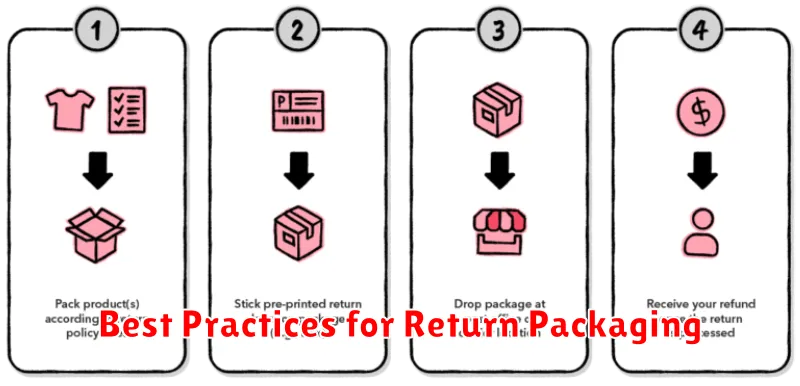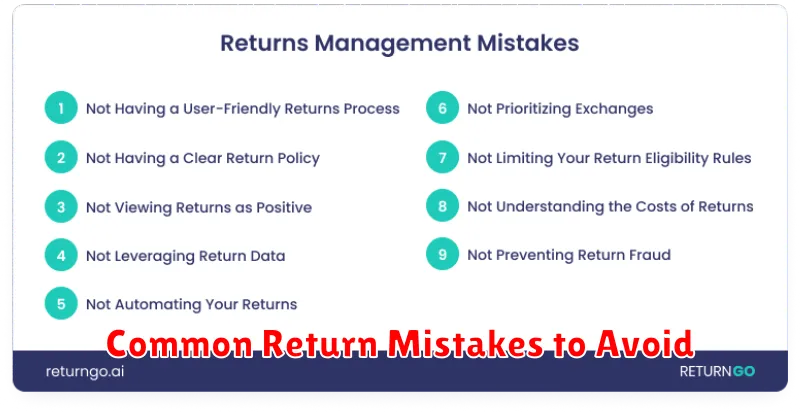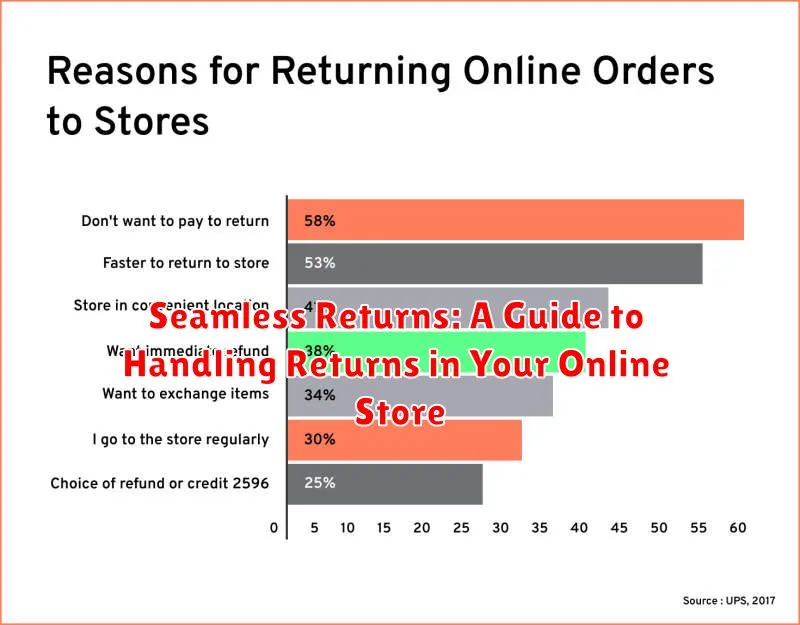Running a successful online store requires more than just attracting customers and making sales. A crucial, yet often overlooked, aspect is establishing a seamless returns process. Returns are an inevitable part of e-commerce, and how you handle them significantly impacts customer satisfaction, loyalty, and ultimately, your bottom line. This guide provides a comprehensive overview of building a customer-centric returns policy that not only minimizes losses but also fosters trust and encourages repeat business. We will explore the importance of handling returns efficiently and delve into strategies for streamlining the returns process to create a positive experience for your customers.
From understanding the legal aspects of returns and crafting a clear returns policy to optimizing logistics and leveraging returns data for valuable insights, this guide covers every key element. Whether you are just starting your online business or looking to improve your existing returns process, implementing the strategies discussed here will empower you to transform returns from a potential challenge into an opportunity to strengthen customer relationships and drive growth. Learn how to make seamless returns a competitive advantage for your online store.
The Importance of a Smooth Return Process
A seamless return process is crucial for the success of any online store. It directly impacts customer satisfaction, loyalty, and ultimately, your bottom line. A positive return experience can convert a potentially negative situation into one that builds trust and encourages repeat business.
Customers view a smooth return process as a sign of a reputable and reliable business. Knowing they can easily return or exchange an item gives them the confidence to make a purchase in the first place. This is particularly important for first-time buyers who may be hesitant to shop with a new online retailer.
Reduced friction during the return process minimizes customer frustration. A complicated or confusing return policy can lead to negative reviews and damage your brand’s reputation. A streamlined process, on the other hand, demonstrates respect for your customers’ time and reinforces their positive perception of your business.
Creating a Clear Return Policy
A well-defined return policy is the cornerstone of a positive return experience. Clarity is key to minimizing confusion and setting customer expectations. Your policy should be easily accessible from your website’s footer and ideally, linked within order confirmations and shipping notifications.
Specify the return window. Clearly state the timeframe within which customers can initiate a return (e.g., 30 days, 60 days). Be upfront about any exceptions, such as final sale items or holiday return extensions.
Outline the conditions for returns. Describe the acceptable condition of returned items. Specify whether tags need to be attached, original packaging required, and the general state the product should be in (e.g., unworn, unused). Be explicit about what constitutes damage and who bears the responsibility for return shipping costs.
Detail the return process. Explain the steps customers need to follow. Should they contact customer support for a Return Authorization Number (RMA)? Is there a dedicated online portal for initiating returns? Provide clear instructions for packaging and shipping the return.
Providing Multiple Return Options
Offering various return methods is key to a positive customer experience. Flexibility is paramount. Consider incorporating these options:
Mail Returns:
Provide a prepaid shipping label within the package or allow customers to download and print one from your website. This simplifies the process and encourages returns.
Drop-off Locations:
Partnering with retail locations or designated drop-off points offers added convenience. This is especially appealing to customers who value speed and ease of access.
In-Store Returns (If Applicable):
If you have a physical store, allowing in-store returns creates a seamless omnichannel experience. This also provides an opportunity for upselling or exchanging items.
Managing Returned Inventory Efficiently
Efficiently managing returned inventory is crucial for minimizing losses and maximizing profitability. A well-structured process can streamline operations and improve customer satisfaction.
Inspection and Sorting: Upon arrival, all returned items should be thoroughly inspected for damage, wear, and completeness. Establish clear criteria for categorizing returns (e.g., resalable, damaged, defective). This initial assessment determines the next steps for each item.
Restocking and Repackaging: Items deemed resalable should be promptly restocked to make them available for purchase again. Ensure proper repackaging to maintain product quality and presentation. Clearly mark returned items if necessary to distinguish them internally.
Liquidation Strategies: For items not suitable for restocking, consider various liquidation options, such as discounted sales, returns to the manufacturer, or donations. Develop a clear protocol for each category to minimize storage costs and maximize recovery value.
Inventory Tracking: Utilize a robust inventory management system to accurately track returned items throughout the entire process. This system should integrate seamlessly with your sales platform to provide real-time visibility into inventory levels.
Processing Refunds Promptly
Timely refunds are crucial for maintaining customer satisfaction and trust. A slow or complicated refund process can lead to negative reviews and damage your brand’s reputation. Aim to process refunds as quickly as possible once the returned item has been received and inspected.
Establish a clear refund timeline in your return policy. For example, state that refunds will be processed within 2-3 business days of receiving the return. Communicate this timeline to the customer throughout the return process to manage expectations.
Choose a refund method that aligns with your customer’s original payment. If the customer paid by credit card, issue the refund back to the same card. For other payment methods, explore options like store credit or direct bank transfers. Clearly communicate the chosen refund method to the customer.
Maintain accurate records of all refunds. This includes the date the refund was processed, the amount refunded, and the method used. This documentation will be valuable for accounting purposes and resolving any potential disputes.
Reducing Return Rates with Proactive Measures
Minimizing returns starts with preventing them in the first place. Detailed product descriptions are crucial. Provide comprehensive information about sizing, materials, and functionalities. Include high-quality images and videos showcasing the product from various angles.
Accurate sizing charts are essential, especially for apparel and footwear. Consider offering a fit guide or virtual try-on tools. Customer reviews also play a significant role. Encourage reviews and address any negative feedback regarding sizing or product discrepancies.
Clear and concise product information minimizes misunderstandings. Highlight key features and benefits, addressing common customer questions proactively. This transparency fosters customer confidence and reduces the likelihood of returns due to unmet expectations.
Analyzing Return Data for Improvement
Analyzing return data is crucial for optimizing your returns process and minimizing future returns. Data-driven decisions provide insights into the reasons behind returns, enabling you to address underlying issues and improve customer satisfaction.
Track key metrics such as return rate (the percentage of orders returned), return reason (sizing issues, damaged goods, etc.), and time to return. Identify trends and patterns in the data.
For instance, a high return rate for a particular product might indicate a problem with its quality, description, or sizing information. A significant number of returns due to “didn’t fit” suggests the need for more detailed size charts or fit guides.
Analyzing return data by customer segment can also reveal valuable insights. Are certain demographics returning items more frequently? Understanding these nuances allows for targeted improvements to product offerings and customer experience.
Using Returns as a Customer Service Opportunity
Returns, while sometimes seen as a hassle, can be a powerful opportunity to foster customer loyalty and enhance your brand’s reputation. Handling returns with grace and efficiency can turn a potentially negative experience into a positive one.
Emphasize clear and easy return policies. A straightforward return process reduces customer anxiety and builds trust. Make sure your policy is easily accessible on your website.
Offer multiple return options. Providing choices, such as mail-back returns, in-store drop-offs (if applicable), or scheduled pick-ups, caters to different customer preferences and enhances convenience.
Provide prompt and proactive communication. Keep customers informed throughout the return process with regular updates via email or SMS. Acknowledge receipt of the returned item and promptly issue refunds or exchanges.
Train your customer service team to handle return inquiries with empathy and professionalism. Empower them to resolve issues quickly and efficiently, offering solutions that satisfy the customer’s needs.
Collect feedback on the return experience. Use surveys or follow-up emails to gather valuable insights into why customers returned items and how you can improve the process. This demonstrates a commitment to customer satisfaction and continuous improvement.
Best Practices for Return Packaging

Streamlining the return packaging process benefits both your business and your customers. Providing easy-to-use return packaging reduces customer frustration and encourages future purchases.
Include a pre-paid return shipping label directly in the original packaging. This eliminates a major hurdle for customers initiating a return. If including a pre-paid label isn’t feasible, offer a clear and accessible method for customers to generate and print their own labels online.
Provide clear instructions for repackaging the item. Simple, step-by-step directions minimize errors and ensure the returned product arrives back to your facility safely. Consider including a checklist or diagram within the packaging to further aid the process.
Offer durable and appropriately sized packaging. The original packaging may not always be reusable. Offering a separate return bag or box ensures the product is protected during transit. Ideally, this return packaging should be made of sustainable materials.
Common Return Mistakes to Avoid

A smooth return process can turn a potentially negative experience into a positive one. However, missteps can damage customer relationships and your bottom line. Avoid these common return mistakes:
Complicated Return Policies: Overly complex or restrictive return policies frustrate customers. Keep your policy clear, concise, and easily accessible.
Hidden Return Costs: Unexpected charges, such as restocking fees or return shipping costs, can deter customers from making future purchases. Be upfront about all potential expenses.
Slow Processing Times: Delayed refunds or exchanges create customer dissatisfaction. Streamline your return process to ensure timely processing.
Poor Communication: Lack of communication throughout the return process leaves customers in the dark. Provide regular updates and tracking information.
Ignoring Return Data: Valuable insights are lost if return data isn’t analyzed. Use this data to identify trends and improve your products or processes.

